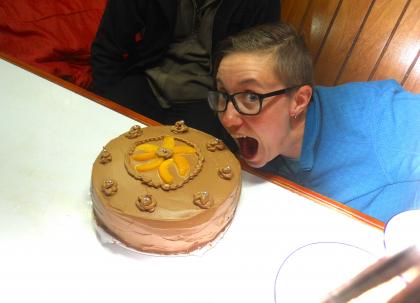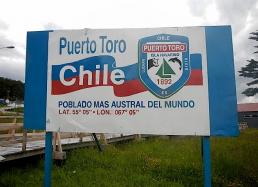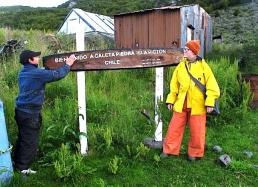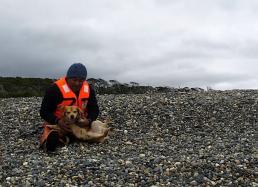Blog #8: Treats & Trip-wires
Cake! Today when we were steaming into Puerto Toro, Ernesto and the crew told me that there is a woman who lives year-round in this small hamlet and often bakes cakes for crews that come into port (see Photo #1 below.) I was so excited by the idea of a bakery-quality cake that I started chanting “Torte! Torte! Torte!”
Indeed, after we finished dinner, the captain left to walk into town and returned with a large cardboard box. Inside was a huge vanilla cake frosted with milk-chocolate icing and filled with peach slices and manjar (sweetened, condensed milk similar to dulce de leche). It has been a long few days, and I think this cake did wonders for morale (see how happy I am in the above photo?)
This morning we were up very early, as it was our only chance to reach Isla Lennox, one of the poorly explored, small islands that have been historically off-limits to everyone but the military (due to leftover landmines from Argentinian and Chilean boundary disputes). With the Chilean Navy’s permission, the team came ashore and divided up to begin collecting. Bill and I began following what we thought was a riverbed that turned out to be a brackish inlet of the ocean.
I collected several interesting epiphytes growing on tree branches and trunks right over the water, including what I think will be a species new to science. (Check out my "Video Journal #9: New Discoveries" for more details, plus amazing views of the old-growth Southern Beech forest we found here. And see the "Beautiful Bryophytes" Photo Gallery for more photos of some of these coastal plants.)
That’s the interesting thing about the liverworts, hornworts, and mosses growing along the Cape Horn Archipelago; normally these bryophytes can’t handle saltwater of any kind, but because the Cape Horn Archipelago gets so much rain, these plants can live right along the salty shoreline, since they're continuously rinsed clean by the ever-present freshwater fog and rainfall.
At one point, Bill and I decided to move further inland, towards what looked like an interesting bog. But as we started to walk in that direction, suddenly Bill fell down—he’d been tripped by a wire strung about a foot off the ground. We looked at each other in horror as we realized the potential meaning of such a trip-wire on an island so heavily fortified with landmines and who knows what else. We both agreed that we’d return to the coast where we felt a little safer.
Yesterday we visited Isla Picton and Isla Nueva (see Photos #2 & #3 below), the other two restricted islands where we’d hoped to get collecting permission. If I thought it was strange to collect in the presence of other people, it’s even stranger to collect under what feels like military surveillance. While it’s good to have records for the species that grow here, I haven’t found these islands to be terribly interesting because the land is very ecologically disturbed by all the human activity. We had only a few hours at each site, so we quickly tried to collect as many species as we could.
We’re now all very tired and the end of the trip is in sight. It’s exhausting to keep collecting while squeezing in care of the specimens in the evenings, and sometimes it’s hard to remain civil and friendly to one another. But in the midst of all this, there are also moments of celebration. Yesterday was Australia Day, and so, in honor of Paddy, we all gathered on the bridge after dinner for a whiskey toast and a round of singing “Waltzing Matilda” (which Bill fortuitously keeps on his iPod).
Tomorrow, we’ll head to another spot on Isla Picton, and then back to Puerto Williams to retrieve the specimens that we left there to dry. We’ll also make one more quick stop to collect some live material closer to our final port, then we’ll begin the long trip home to Punta Arenas.
Once we’re back in the city, we’ll finish any remaining microscope work (which I’m sure there’ll be plenty of!), and we’ll complete the drying and packing of the specimens to be sent home. (Some of our collection will remain here in Chile, and some will go back to the home institutions of the other participating scientists.)
So, like I said, the end is in sight, but there’s still much work to be done....
Laura








